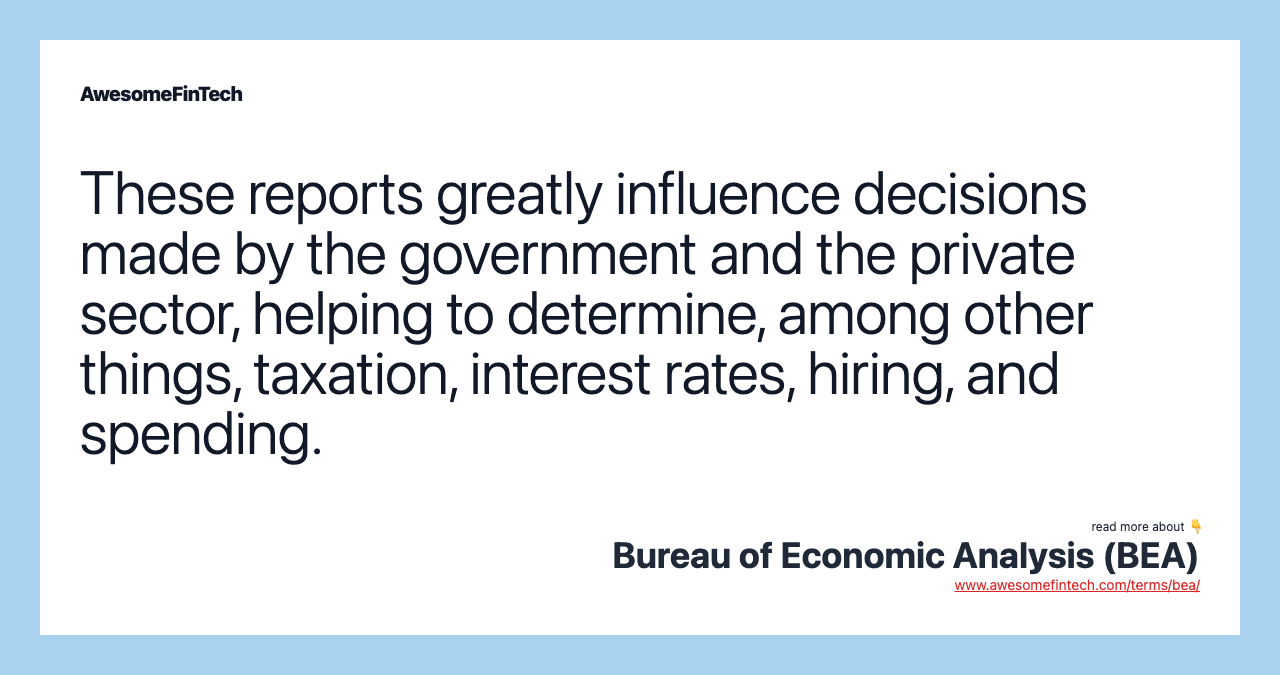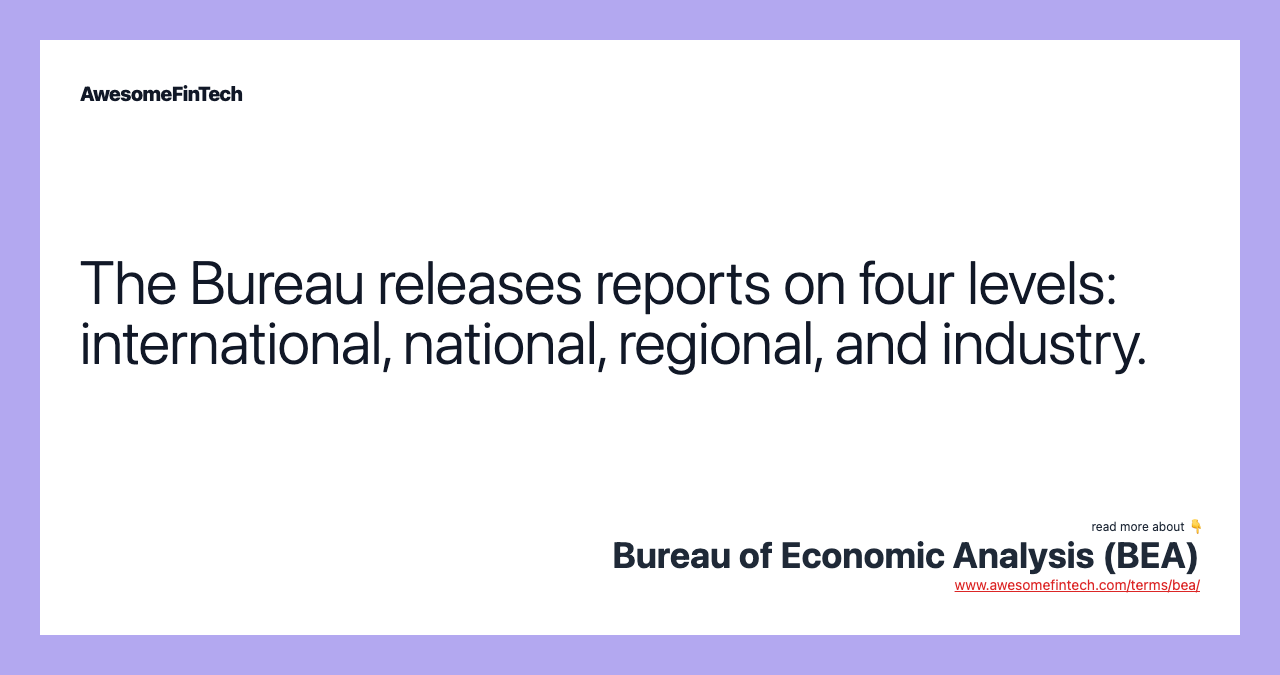Bureau of Economic Analysis (BEA)
The Bureau of Economic Analysis (BEA) is a division of the U.S. federal government's Department of Commerce that is responsible for the analysis and reporting of economic data used to confirm and predict economic trends and business cycles. The Bureau of Economic Analysis (BEA) does not interpret data or make forecasts. Among the most influential statistics analyzed and reported by the BEA are gross domestic product (GDP) data and the U.S. balance of trade (BOT). The Bureau of Economic Analysis (BEA) is a division of the U.S. federal government's Department of Commerce that is responsible for the analysis and reporting of economic data used to confirm and predict economic trends and business cycles. The Bureau of Economic Analysis (BEA) is a division of the U.S. Department of Commerce responsible for the analysis and reporting of economic data. The BEA says its mission is to promote a better understanding of the U.S. economy by providing the most timely, relevant, and accurate economic accounts data in an objective and cost-effective manner.

More in Economy
What Is the Bureau of Economic Analysis (BEA)?
The Bureau of Economic Analysis (BEA) is a division of the U.S. federal government's Department of Commerce that is responsible for the analysis and reporting of economic data used to confirm and predict economic trends and business cycles.



Understanding the Bureau of Economic Analysis (BEA)
Reports from the BEA greatly influence government economic policy decisions, investment activity in the private sector, and buying and selling patterns in global stock markets. The BEA says its mission is to promote a better understanding of the U.S. economy by providing the most timely, relevant, and accurate economic accounts data in an objective and cost-effective manner. To achieve its goal, the government agency taps into a vast array of data collected at local, state, federal, and international levels. Its job is to summarize this information and present it promptly and regularly to the public.
Reports are released at international, national, regional, and industry levels. Each one contains information on key factors such as economic growth, regional economic development, inter-industry relationships, and the nation's position in the world economy. This means that a lot of the information the bureau publishes is very closely monitored.
In fact, the BEA's data is known to regularly influence things like interest rates, trade policy, taxes, spending, hiring, and investing. Because of the huge impact that they have on the economy and corporate decision-making, it is not unusual to see financial markets move considerably on the day the BEA's data is released, particularly if the numbers diverge considerably from expectations.
The Bureau of Economic Analysis (BEA) does not interpret data or make forecasts.
Statistics Analyzed by the BEA
Among the most influential statistics analyzed and reported by the BEA are gross domestic product (GDP) data and the U.S. balance of trade (BOT).
Gross Domestic Product (GDP)
The GDP report is one of the BEA's most crucial outputs. It tells us the monetary value of all the finished goods and services produced within a country's borders in a specific time period.
If the growth rate is slowing, policymakers might consider introducing an expansionary policy to give the economy a lift. If, on the other hand, the economy is running at full throttle, a decision might be made to curb inflation and discourage spending.
Though GDP is usually calculated on an annual basis, it can be calculated on a quarterly basis as well — in the United States, for example, the government releases an annualized GDP estimate for each quarter and also for an entire year.
GDP has been ranked as one of the three most influential measures that affect U.S. financial markets and is credited as the Department of Commerce's greatest achievement of the 20th century.
Balance of Trade (BOT)
The balance of trade (BOT) measures economic transactions between a nation and its trading partners, showing the difference between the value of a country's imports and exports for a given period.
The BEA reports on the U.S. balance of payments (BOP), covering goods and services that move in and out of the country. Economists use this information to gauge the relative strength of a country's economy. When exports are higher than imports, it tends to boost GDP. In the opposite scenario, it creates a trade deficit.
A trade deficit typically tells us that a country is not producing enough goods for its residents, forcing them to buy them abroad. A deficit can also signal that a country’s consumers are wealthy enough to purchase more goods than their country churns out.
Related terms:
Annualize
Annualizing a number means converting a short-term calculation or rate into an annual rate. read more
Balance of Payments (BOP)
The balance of payments (BOP) is a statement of all transactions made between entities in one country and the rest of the world over a defined period of time, such as a quarter or a year. read more
Balance of Trade (BOT)
Balance of trade is the difference between the value of a country's exports and the value of its imports; it is the largest component of a country's balance of payments. read more
Business Cycle : How Is It Measured?
The business cycle depicts the increase and decrease in production output of goods and services in an economy. read more
Central Bank
A central bank conducts a nation's monetary policy and oversees its money supply. read more
Consumer Spending
Consumer spending is the amount of money spent on consumption goods in an economy. read more
Contraction
A contraction is a phase of the business cycle where a country's real gross domestic product (GDP) has declined for two or more consecutive quarters, moving from a peak to a trough. read more
Department of Commerce (DOC)
Department of Commerce is the cabinet department in the U.S. government that deals with business, trade, and commerce to ensure economic vitality. read more
Economic Conditions
Economic conditions are the state of the economy in a country or region and change over time in line with the economic and business cycle. read more
Economic Growth
Economic growth is an increase in an economy's production of goods and services. read more